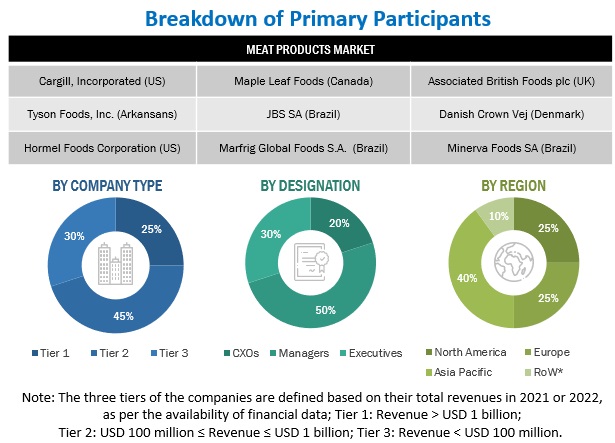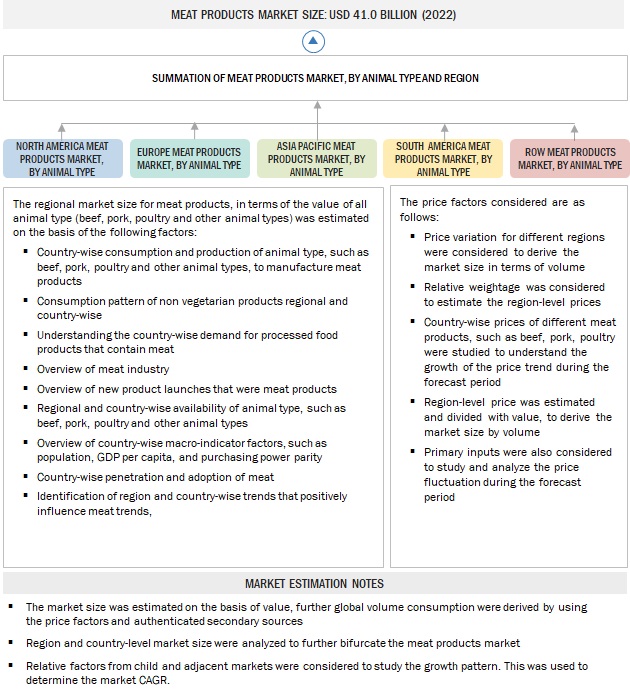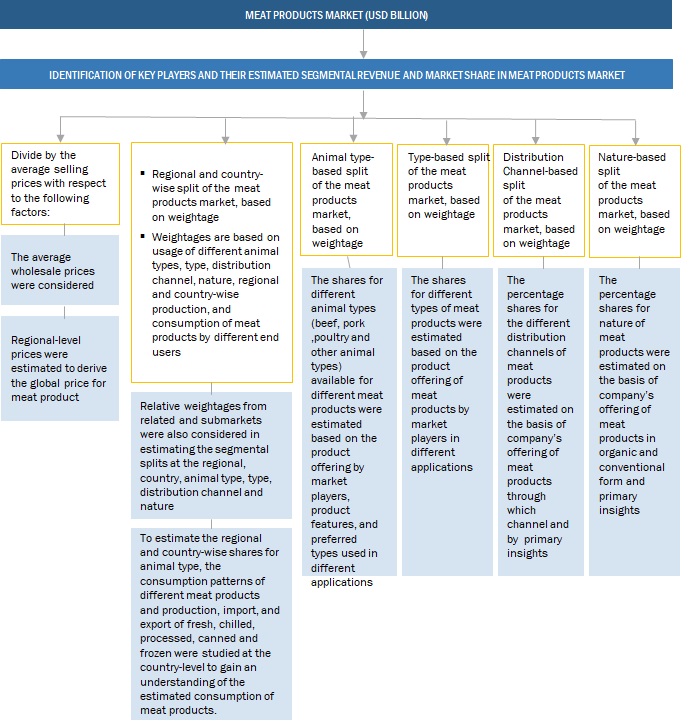The study involved three major segments in estimating the current size of the meat products market. Exhaustive secondary research was done to collect information on the market, peer, and parent markets. The next step was to validate these findings, assumptions, and sizing with industry experts across the value chain through primary research. Both top-down and bottom-up approaches were employed to estimate the complete market size. After that, market breakdown and data triangulation were used to estimate the market size of segments and subsegments.
Secondary Research
This research study involved the extensive use of secondary sources—directories and databases such as Bloomberg Businessweek and Factiva—to identify and collect information useful for a technical, market-oriented, and commercial study of the meat products market.
In the secondary research process, various sources such as annual reports, press releases & investor presentations of companies, white papers, food journals, certified publications, articles from recognized authors, gold & silver standard websites, directories, and databases, were referred to identify and collect information. This research study involved the extensive use of secondary sources—directories and databases such as Bloomberg Businessweek and Factiva—to identify and collect information useful for a technical, market-oriented, and commercial study of the meat products market.
Secondary research was mainly used to obtain key information about the industry’s supply chain, the total pool of key players, and market classification and segmentation as per the industry trends to the bottom-most level, regional markets, and key developments from both market- and technology-oriented perspectives.
Primary Research
Extensive primary research was conducted after obtaining information regarding the meat products market scenario through secondary research. Several primary interviews were conducted with market experts from both the demand and supply sides across major countries of North America, Europe, Asia Pacific, South America, and the Rest of the World. Primary data was collected through questionnaires, emails, and telephonic interviews. The primary sources from the supply side included various industry experts, such as Chief X Officers (CXOs), Vice Presidents (VPs), Directors, from business development, marketing, research, and development teams, and related key executives from distributors, and key opinion leaders. Primary interviews were conducted to gather insights such as market statistics, data on revenue collected from the products and services, market breakdowns, market size estimations, market forecasting, and data triangulation. Primary research also helped in understanding the various trends related to meat products, animal type, type, distribution channel, nature, packaging and region. Stakeholders from the demand side, such as meat companies who manufacture the raw meat products were interviewed to understand the buyer’s perspective on the suppliers, products, and their current usage of meat products and the outlook of their business which will affect the overall market.

To know about the assumptions considered for the study, download the pdf brochure
|
COMPANY NAME
|
designation
|
|
Cargill (US)
|
General Manager
|
|
Tyson Foods, Inc. (Arkansans)
|
Sales Manager
|
|
Hormel Foods Corporation (US)
|
Manager
|
|
Maple Leaf Foods (Canada)
|
Head of processing department
|
|
JBS SA (Brazil)
|
Marketing Manager
|
|
Marfrig Global Foods S.A. (Brazil)
|
Sales Executive
|
|
Associated British Foods plc (UK)
|
Head - Research & Development
|
|
Danish Crown Vej (Denmark)
|
Senior Engineering Manager
|
|
Minerva Foods SA (Brazil)
|
Manager
|
|
Vion Group (Netherlands)
|
R&D, QC and production Expert
|
Meat Products Market Size Estimation
Both the top-down and bottom-up approaches were used to estimate and validate the total size of the meat products market. These approaches were also used extensively to determine the size of various subsegments in the market. The research methodology used to estimate the market size includes the following details:
-
The key players in the industry and the overall markets were identified through extensive secondary research.
-
All shares, splits, and breakdowns were determined using secondary sources and verified through primary sources.
-
All possible parameters that affect the market covered in this research study were accounted for, viewed in extensive detail, verified through primary research, and analyzed to obtain final quantitative and qualitative data.
-
The research included the study of reports, reviews, and newsletters of top market players, along with extensive interviews for opinions from leaders, such as CEOs, directors, and marketing executives.
Global Meat Products Market: Bottom-Up Approach

To know about the assumptions considered for the study, Request for Free Sample Report
Global Meat Products Market: Top-Down Approach

Data Triangulation
After arriving at the overall market size from the estimation process explained above, the total market was split into several segments and subsegments. Data triangulation and market breakdown procedures were employed to estimate the meat products market and arrive at the exact statistics for all segments and subsegments. The data was triangulated by studying numerous factors and trends from the demand and supply sides. The market size was also validated using both the top-down and bottom-up approaches.
Market Definition
-
According to the Food Safety and Standards Authority of India (FSSAI), “Meat Food Products’ means any article of food, or any article intended for, or capable of, being used as a food which is derived or prepared from meat by means of drying, curing, smoking, cooking, seasoning, flavouring.”
-
According to the American Meat Science Association, “meat is a skeletal muscle and associated tissues derived from mammals as well as avian and aquatic species.”
-
The meat products market is characterized by a diverse array of animal types, including beef, pork, poultry, lamb, and goat, each contributing distinct flavors to culinary offerings. Traditional staples like beef and pork remain popular, while poultry caters to the demand for leaner options. This dynamic landscape ensures that consumers can choose from a wide range of meat products, meeting traditional preferences and accommodating evolving dietary trends.
Key Stakeholders
-
Raw Meat Suppliers and Manufacturers
-
Meat Products Importers and Exporters
-
Meat Products Traders and Distributors
-
Government and Research Organizations
-
Meat Manufacturing Companies
-
Associations and Industrial Bodies
-
Manufacturers and suppliers related to meat and the meat products industry.
-
Concerned government authorities, commercial R&D institutions, and other regulatory bodies.
-
Regulatory bodies such as
-
US Food and Drug Administration (FDA)
-
European Commission (EC)
-
United States Department of Agriculture (USDA)
-
Commercial research & development (R&D) institutions and financial institutions
-
Food and Agriculture Organization (FAO)
-
Intermediary suppliers such as wholesalers and dealers
Report Objectives
-
To determine and project the size of the meat products market with respect to the animal type, type, distribution channel, nature, packaging (qualitative), end users (qualitative), and region in terms of value and volume over five years, ranging from 2023 to 2028.
-
To identify the attractive opportunities in the market by determining the largest and fastest-growing segments across regions
-
To provide detailed information about the key factors influencing market growth (drivers, restraints, opportunities, and challenges)
-
To analyze the opportunities in the market for stakeholders and provide details of the competitive landscape for market leaders.
-
To analyze the micro-markets with respect to individual growth trends, prospects, and their contribution to the total market.
-
To identify and profile the key players in the meat products market.
-
To understand the competitive landscape and identify the major growth strategies adopted by players across the key regions.
-
To provide insights on key product innovations and investments in the meat products market.
Available Customizations
With the given market data, MarketsandMarkets offers customizations according to company-specific scientific needs.
The following customization options are available for the report:
Product Analysis
-
Product Matrix, which gives a detailed comparison of the product portfolio of each company.
Geographic Analysis
With the given market data, MarketsandMarkets offers customizations according to company-specific scientific needs.
-
Further breakdown of the European region by Rest of the European countries.
-
Further breakdown of the Rest of Asia Pacific meat products market into Indonesia, Malaysia, Pakistan, Philippines, Thailand, Vietnam, and South Korea.
Company Information
-
-
Detailed analyses and profiling of additional market players (up to five)



Growth opportunities and latent adjacency in Meat Products Market